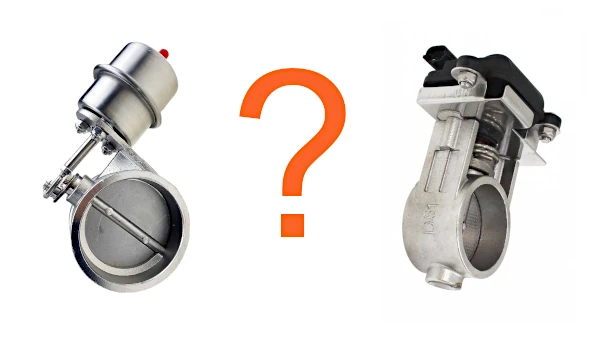Comparing Vacuum Controlled and Electronically Controlled Valve in Aftermarket Valved Exhaust
When exploring the realm of exhaust system enhancements, making a pivotal decision regarding an aftermarket valved exhaust equipped with either vacuum-controlled or electronically-controlled valves significantly shapes the overall driving experience. These versatile valve systems grant drivers the power to finely tune the exhaust note and flow, tailoring them to a variety of driving scenarios and individual preferences.
Vacuum-Controlled Valve: Simplicity with Effective Engineering

Aftermarket valved exhaust systems utilizing vacuum controlled valve operate by harnessing engine vacuum or an additional vacuum pump controller to generate overpressure or vacuum pressure, thus regulating the valve's opening and closing. While the installation process tends to be more intricate, these systems exhibit heightened reliability due to their absence of electronics, ultimately translating to a more cost-effective solution.
Diverse Types of Pneumatic Valves in Aftermarket Valved Exhaust
Pneumatic valves within aftermarket valved exhaust systems present diverse operational characteristics, leading to distinct categories:
- Valve Normally Open with Vacuum Close: This setup keeps the valve open until manifold vacuum is applied (or additional vacuum pump), allowing it to remain open during full throttle but closing under light load. Ideal for those aiming for a subtle exhaust note at idle and cruise, while delivering a race-inspired resonance during wide-open throttle.
- Valve Normally Closed with Vacuum Open: In contrast, this configuration maintains the valve closed until manifold vacuum (or additional vacuum pump) triggers its opening during full throttle, with the valve staying open under light load. Suited for applications seeking a reserved exhaust note at idle and cruise, transforming into an assertive roar at wide-open throttle.
- Valve Normally Closed with Boost Open: This design keeps the flow diverted until the actuator senses positive boost pressure, prompting the valve's opening. Tailor-made for boosted applications in pursuit of a serene exhaust tone at idle and an exhilarating growl during wide-open throttle.
Pros and Cons of Vacuum-Controlled Valve in Exhaust Systems
Pros:
- Simplicity: Vacuum-controlled systems often have fewer electronic components, making them relatively straightforward and reliable.
- Cost-Effective: Due to their simpler design, vacuum-controlled systems are usually more budget-friendly.
- Proven Reliability: The lack of electronics can contribute to increased durability and less susceptibility to electronic failures.
Cons:
- Limited Precision: Adjustments may be less precise compared to electronically controlled systems.
- Reduced Customization: Fine-tuning options might be more limited, offering fewer sound variations.
- Installation Complexity: Vacuum-controlled systems can be more intricate to install due to additional components like pumps, non-return and solenoid valves.
Electronically Controlled Valve: Precision and Tailored Control in Your Aftermarket Valved Exhaust

Conversely, the realm of electronically controlled valve introduces a new dimension of precision and customization in aftermarket valved exhaust setups. These systems employ electronic sensors and actuators to dynamically adjust the valve's positioning based on parameters such as rotational speed, throttle input, and driving mode. It all depends on the controller used and its programming. This real-time adaptability enables drivers to select from a spectrum of exhaust modes, ranging from refined notes for daily commutes to a commanding bellow on open roads. It's noteworthy that they also exhibit quicker responsiveness. While concerns about electronic vulnerability arise, manufacturers have made strides in enhancing the durability of these mechanisms.
Pros and Cons of Electronically Controlled Valve in Exhaust Systems
Pros:
- Precision Control: Electronically controlled systems allow for precise adjustments based on various driving parameters.
- Customization: A wide range of exhaust modes cater to different driving scenarios and sound preferences.
- Integration: These systems often integrate seamlessly with existing setups and provide real-time adaptability.
Cons:
- Higher Cost: Electronics and additional components can make electronically controlled systems more expensive.
- Potential Vulnerability: Electronics might be more susceptible to damage or malfunctions, though durability has improved.
- Installation Considerations: Installation might require more technical expertise due to electronic components.
Choosing Your Ideal Control System in Your Aftermarket Valved Exhaust
Ultimately, the selection between vacuum-controlled and electronically controlled valve systems in your aftermarket valved exhaust hinges on your desire for control and the driving experience you envision. If a straightforward dual-tone setup appeals to you, the vacuum-controlled valve could be the answer. Yet, be mindful of the associated vacuum pump noise(if it is installed), which some users find bothersome. Alternatively, consider a setup where vacuum is generated from the engine itself, potentially mitigating the noise concern.
It is important to ascertain how the system will function post-installation. While numerous configurations are available on the market, it is common to encounter valved exhaust systems in which the flaps of the valve either fully open or close; there might be no intermediate options or options adapted to the current engine load.
For those seeking meticulous sound and performance control, the electronically controlled valve system offers a spectrum of options to elevate your driving satisfaction with your aftermarket valved exhaust. Regardless of your choice, both systems contribute to the vibrant symphony of your vehicle's exhaust note, enhancing every journey.
If your car is already equipped with a factory-installed controlled exhaust system, it might be worth considering choosing a new exhaust system based on the same valve control system. Carefully contemplating this aspect can save you time, money, and potential vehicle modifications.
Furthermore, the tightness of the flaps in the valve deserves attention. Valves with leaky flaps, factory-installed smaller flaps, or those featuring an opening can lead to a substantial increase in volume. To avoid minor discrepancies in sound levels across different modes and potential undesirable noises or flap vibrations, it is recommended to opt for fully sealed flaps upon closure.
In summary, the choice between a vacuum-controlled and electronically-controlled valved exhaust system introduces another layer of personalization. Each control system presents distinct merits, and your decision should harmonize with your driving style and preferences.
Diverse Exhaust Flap Valve Types: A Thorough Investigation
Boost Your Car's Style and Performance with the Universal Valved Muffler (Valvetronic)
